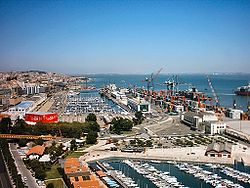Our website is made possible by displaying online advertisements to our visitors.
Please consider supporting us by disabling your ad blocker.
Lisbon Region
Lisbon
Região de Lisboa | |
|---|---|
 The port of Lisbon, the terminus of activities in the Region of Lisboa, that extends into Tagus estuary | |
| Etymology: Lisboa, Portuguese for Lisbon | |
 Location of the Lisbon Region in context of the national borders | |
| Country | |
| Capital | Lisbon |
| Area | |
• Total | 3,001.95 km2 (1,159.06 sq mi) |
| Population (2011) | |
• Total | 2,815,851 (2nd) |
| GDP | |
| • Total | €87.368 billion (2022) |
| • Per capita | €30,642 (2022) |
| Time zone | UTC+0 (WET) |
| • Summer (DST) | UTC+1 (WEST) |
| ISO 3166 code | PT-11 |
| NUTS | PT17 |
| Statistics from INE (2005); geographic detail from Instituto Geográfico Português (2010) | |
Lisbon Region (Portuguese: Região de Lisboa) is one of the seven NUTS II designated regions of Portugal, which coincides with the NUTS III subregion Lisbon Metropolitan Area. The region covers an area of 3001.95 km2 (the smallest region on mainland Portugal) [3] and includes a population of 2,815,851 inhabitants according to the 2011 census (the second most populated region in Portugal after the Norte region),[4] a density of 1039 inhabitants/km2.
Considered as representing the Lisbon Metropolitan Region. It is a region of significant importance in industry (light and heavy), services, and it is highly urbanized. The gross domestic product (GDP) of the region was 73.3 billion euros in 2018, accounting for 36% of Portugal's economic output. GDP per capita adjusted for purchasing power was 30,200 euros or 100% of the EU27 average in the same year. The GDP per employee was 92% of the EU average.[5]
- ^ "Produto interno bruto (B.1*g) a preços correntes (Base 2016 - €) por Localização geográfica (NUTS - 2013); Anual". www.ine.pt. Retrieved 3 September 2023.
- ^ "Produto interno bruto (B.1*g) por habitante a preços correntes (Base 2016 - €) por Localização geográfica (NUTS - 2013); Anual". www.ine.pt. Retrieved 3 September 2023.
- ^ Statistical Yearbook of Portugal 2012. Instituto Nacional de Estatística. p. 50.
- ^ "Censos 2011 Resultados Preliminares 2011". INE.
- ^ "Regional GDP per capita ranged from 30% to 263% of the EU average in 2018". Eurostat.
Previous Page Next Page


